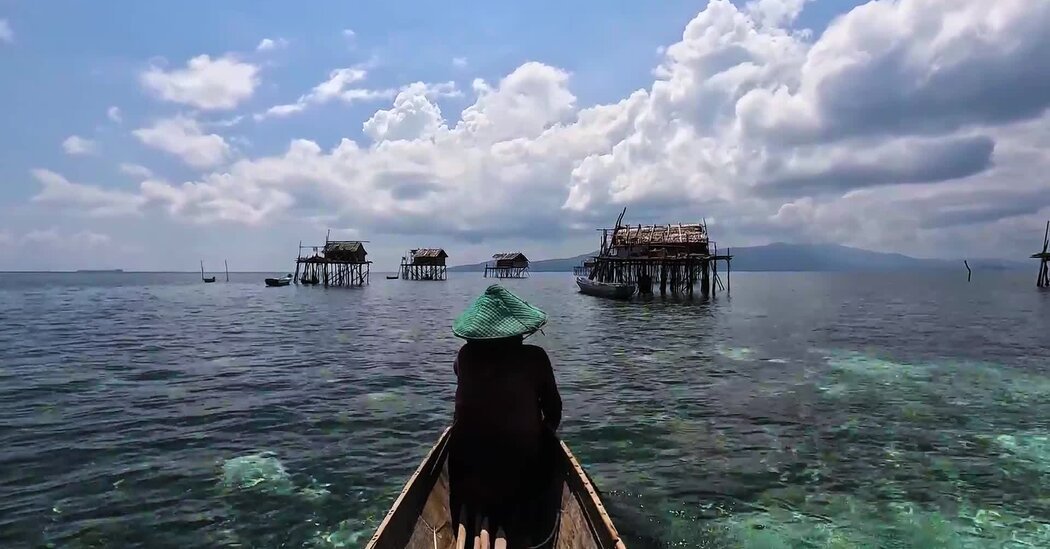Leaving her hut that hovered on stilts above crystal blue water, Zausiyah got into her boat at sunrise and rowed out to sea, looking down into the clear water for fish.
When she found a choice spot, she stored her paddle, baited four hooks and tossed her line down into the deep waters of the Molucca Sea in Indonesia.
Sometimes the hooks came back empty; other times she caught four fish in one throw.
“Fishing is the only thing we, the Bajo people, know,” sighed Zausiyah, who like many Indonesians goes by one name. “I started fishing when my husband went blind. I’m tired, but this is our only way to earn a living.”

Before noon, she was making her way back home, her hut one of a dozen dotting these waters, off the east-central coast of the island of Sulawesi. Wooden boats bobbed beneath each home, where shellfish hung down by string and sea cucumbers were scattered on the decks, drying in the scorching sun.
Before climbing back into her home, which rose about 10 feet above the water, Zausiyah bartered her fish for some cookies with neighbors who had just returned from the mainland.
For centuries, the Bajo people have traditionally lived on the open sea, spending a large part of their nomadic lives in their boats or in these offshore huts, which are supported by wooden poles anchored to the sea bottom.
Bajo communities are scattered throughout the waters off the coasts of Indonesia, the Philippines and Malaysia. In Indonesia, about 180,000 Bajo people are estimated to be spread across 14 provinces.
Traditionally, the Bajo came ashore only to trade for supplies or to shelter from storms.
But beginning in the late 1980s, Indonesia started to develop settlements on land for the Bajo and to improve the services available to them, leading to more of them adopting a hybrid approach, splitting their time between sedentary lives on solid ground and lives at sea. Some have given up their seaborne lives entirely.
Zausiyah, who says she is in her 60s, and her husband, Mawardi, around 72, have stuck with the sea, though Mawardi lost most of his sight after an accident involving explosives that he was using to fish.
Their children, who live on land (sort of) in a nearby village, take turns visiting them regularly and bringing supplies like rice, cooking oil, fresh water and wood.
The children’s village is on Peleng, one of the largest of the Banggai Islands, an archipelago that is part of the province of Central Sulawesi.
While the village is attached to the land, much of it is still not really a part of it. Clusters of wooden huts are built out over the shallow water just off shore, the homes connected by footbridges.
As with the Bajo huts further out on the water like Zausiyah’s, the evidence of a life based on the sea’s resources is everywhere, with dried fish spread out on wooden surfaces and fishermen carrying their fresh catch to a small marketplace.
Only is the village’s edge actually on land, with motorcycles coming and going on the lone gravel road that connects it to the rest of the world.
But even the village’s liminal state between sea and land is a far cry from life lived on open water.
“Things have changed a lot here,” recalled Sunirco, the leader of the Indonesian Bajau People Association, an advocacy group. “This village used to be all mangrove, and I had to swim to go to school if I could not catch a boat ride. Unlike our ancestors, we are no longer boat dwellers.”
Off the island, a fisherman, Wardi, and some of his relatives were tending a 50-foot-wide stationary fish trap, or sero. The traps are placed to intercept migrating fish, with the best spots handed down from generation to generation.
The morning tranquillity out at sea was broken when a school of skipjack tuna were spotted heading into the trap, which has an open fence at one end and a net at the other.
“Get ready, they’re coming,” yelled Wardi from his observation post.
Some of his fellow fishermen began rowing their boats to the edges of the trap. Wardi watched as the school of fish veered into it. “They are in. Close the gate,” he shouted.
Five fishermen then dove into the sea to wrap the net around the day’s catch. It took a team effort to left it out of the water, but the three boats were soon filled to the brim with about 300 flapping skipjacks. Cheers went up at the sight.
While placing the traps at the perfect spot in the path of the migrating fish depends upon traditional knowledge, the Bajo have adopted some more modern approaches to extracting the sea’s bounty.
Long renowned for their free diving skills — plunging under water without oxygen — some now use breathing equipment to help them go deeper and stay under water longer as they hunt for fish. Traditional wooden goggles have been replaced by store-bought plastic ones.
And with more options for a land-based life, some younger Bajo are opting not to fish at all, and there is concern that traditional customs are being lost.
However well-intentioned some of the government interventions may be, they are typically done from the perspective of people accustomed to life on land and ignorant of Bajo culture. In one case, a health center was built in an area considered off-limits by the Bajo, and no one would go. And while the government tends to push concrete homes and footbridges as sturdier alternatives to wood, they can feel unnatural to, and unwanted by, the Bajo.
To those who study the Bajo, there’s little question the culture is increasingly assimilating to life on land and is losing touch with its nomadic, seafaring past.
“The Bajo we see today are not the Bajo that we used to know,” said Wengki Ariando, a researcher at Chulalongkorn University in Bangkok who has studied the culture and said many Bajo were “have lost their identity.”
Before the Bajo culture diminishes further or even disappears altogether, advocates for its survival hope the younger generation will want to maintain a connection to the sea even as they embrace more grounded lifestyles.
For Zausiyah and Mawardi, however, life on land has little appeal: The sea is home.
They believe there are deep spiritual connections between the Bajo and the ocean and that the community’s taboos should be upheld to avoid risking a reprimand from the spirit of the sea. They’re worried the younger generation is failing to follow the rules or is even forgetting entirely what offends.
To throw out rice or other food into the sea is taboo, as is entering a sacred area or speaking loudly and disrespectfully in nature. “The young generations should understand that nature will give us a warning if we cross the taboos,” Zausiyah said.
After some consideration, her husband, Mawardi, conceded that the younger generation views the sea with less reverence than he does.
“The young people nowadays are different,” he said. “They don’t even listen to us, their elders, let alone listen to nature.”










